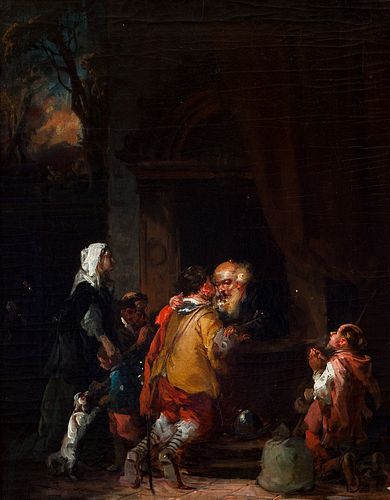Attributed to EUGENIO LUCAS VELÃZQUEZ (Madrid, 1817 - 1870). Untitled. Oil on canvas.
Lot 99
About Seller
Setdart Auction House
Carrer Aragó 346
Barcelona
Spain
Setdart Subastas was born in 2004 and is currently the first online art auction in Spain with solidity, prestige and reliability guaranteed by our more than 60,000 users. Setdart has a young, dynamic and enterprising team ready to successfully manage the purchase and sale of art works through custom...Read more
Estimate:
EUR€2,000 - EUR€2,500
$2,150.54 - $2,688.17
Absentee vs Live bid
Two ways to bid:
- Leave a max absentee bid and the platform will bid on your behalf up to your maximum bid during the live auction.
- Bid live during the auction and your bids will be submitted real-time to the auctioneer.
Bid Increments
| Price | Bid Increment |
|---|---|
| EUR€0 | EUR€10 |
| EUR€200 | EUR€25 |
| EUR€500 | EUR€50 |
| EUR€1,000 | EUR€100 |
| EUR€3,000 | EUR€200 |
| EUR€5,000 | EUR€500 |
| EUR€10,000 | EUR€1,000 |
| EUR€20,000 | EUR€2,000 |
| EUR€50,000 | EUR€5,000 |
About Auction
By Setdart Auction House
Nov 10, 2021
Set Reminder
2021-11-10 08:00:00
2021-11-10 08:00:00
America/New_York
Bidsquare
Bidsquare : 19th & 20th Century paintings and Decorative Arts
https://www.bidsquare.com/auctions/setdart-auction-house/19th-20th-century-paintings-and-decorative-arts-7800
Setdart Auction House sofia@setdart.com
Setdart Auction House sofia@setdart.com
- Lot Description
Attributed to EUGENIO LUCAS VELÃZQUEZ (Madrid, 1817 - 1870). Untitled. Oil on canvas. It is paired with lot 35077613. 50 x 38 cm; 67 x 56 cm (frame). Mentioned since the 19th century as Eugenio Lucas Padilla, or Eugenio Lucas the Elder, he was the Spanish Romantic artist who best understood Goya's art. Trained in the neoclassicism of the Academy of San Fernando, he soon turned his training around and dedicated himself to the study of Velázquez and, above all, Goya, whose works he admired and copied in the Prado Museum. In Goya's painting, Lucas Velázquez found the starting point to develop an imaginative personal painting, of fantastic visions and unleashed passions, within the purest romantic style. He also took the subject matter from Goya, and painted scenes of the Inquisition, covens, pilgrimages and bullfights. He also painted, in 1850, the now disappeared ceiling of the Royal Theater of Madrid, and later he was named honorary chamber painter and knight of the order of Carlos III by Queen Isabel II. As a good romantic, he made several trips, among which his stays in Italy, Morocco and Paris stand out. His works are characterized by the use of a spirited brushstroke and a casual style, without draftsmanship concerns, with a dense and impastoed matter of great chromatic richness and with the presence of strong chiaroscuro. He achieved great success as a painter of manners and scenes of fantastic and sinister character, although it is true that he was also an excellent landscape painter and portraitist. His work is well represented in the Prado Museum, and also in other centers such as the Bilbao Fine Arts Museum, the National Art Museum of Catalonia, the Lázaro Galdiano Museum, the British Museum, the Metropolitan Museum of New York and the Goya Museum in Castres (France).
- Shipping Info
-
In-house shipping available. Please inquire at admin@setdart.com.
-
- Buyer's Premium



 EUR
EUR CAD
CAD AUD
AUD GBP
GBP MXN
MXN HKD
HKD CNY
CNY MYR
MYR SEK
SEK SGD
SGD CHF
CHF THB
THB















